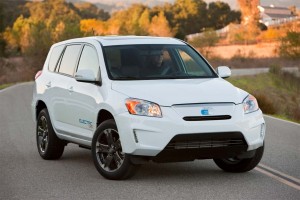
Toyota will build the RAV4 EV on the same Ontario assembly line producing the conventional version of the crossover.
Toyota today launched its all-new battery-electric vehicle, the RAV4-EV, at the annual International Electric Vehicle Symposium, in Los Angeles. Based on the maker’s conventionally powered compact ute, the vehicle is intended to test the U.S. market’s interest in electric propulsion.
But it will also be a test of the budding relationship between the Japanese giant and the small California start-up Tesla Motors. The guts of the RAV4-EV, its lithium-ion driveline, will come from Tesla, a company in which Toyota has so far invested more than $50 million and dangled millions more in contracts like the new electric vehicle.
More broadly, it’s a test of a significant shift in strategy by the Japanese maker. For most of its existence, the company – currently the world’s fourth-largest automaker – steadfastly did things on its own. While other manufacturers frequently partnered with erstwhile rivals to fill gaps in their product and powertrain line-ups, Toyota reached into its vast treasury to fund its own programs or worked with a very small and select group of suppliers – known as a keiretsu — in which it usually held a significant financial stake.
No longer. Toyota is rapidly lining up an assortment of alliances with not only some of the world’s most prestigious auto manufacturers but also some of its fiercest competitors.
“No one can handle it all by themselves,” acknowledged Yoshi Inaba, president and COO of Toyota Motor North America.
The RAV4-EV is a significant example of Toyota’s new strategy. Two decades ago, when Toyota produced an earlier electric vehicle to comply with a short-lived zero-emissions mandate in California, it followed its typical path, developing the vehicle internally. And it might have seemed logical to do that again this time. After all, Toyota produces the various Prius hybrids, the original being the world’s best-selling gas-electric automobile.
But Toyota has been reluctant to invest in more advanced battery technology, especially lithium-ion systems, having had some problems in recent years using what had seemed a particularly promising version of lithium chemistry that turned out to be prone to defects. Compounding the situation, there is still wide debate over the market’s interest in electric vehicles.
So, Toyota decided to have its engineers focus on a halfway project, the new Prius plug-in, and let little Tesla do the work on the still more advanced RAV4-EV, which is rated to get 100 miles per charge.
It isn’t the first time Toyota has partnered with another manufacturer. In fact, it was allied with General Motors for a quarter century as part of the NUMMI venture. That alliance was created as a reluctant quid pro quo, providing Toyota an easy way to test the waters of U.S. manufacturing while GM get a look inside what was then unquestionably the most advanced automotive manufacturing system in the world.
The venture was scrapped after GM emerged from bankruptcy in 2009. Toyota has since sold the NUMMI factory, in the San Francisco suburb of Fremont, to Tesla. The small firm plans to use it to produce its own new battery-electric vehicles, the Model S and Model X.
The Tesla alliance is just one of many new partnerships for Toyota. The maker is just rolling out the new Scion FR-S, a sports coupe that will be marketed through its youth-oriented division in the U.S. and sold as the Toyota GT86 elsewhere. It was developed as part of a joint venture with Subaru, which Toyota purchased a small stake in several years ago.
Subaru’s Indiana assembly plant also helps Toyota meet production demands in the U.S. by producing some Camry models.
There’s also a new alliance between Toyota and BMW. The Bavarian maker will provide some much-needed diesel engines that will be used in Toyota’s European products starting in 2014. That could prove particularly helpful as Toyota has been struggling to take on German rival Volkswagen AG in the Continental market where diesels currently account for about half of all new vehicle sales.
Toyota has also been working up alliances with Ford Motor Co. as well as major non-automotive partners including both Microsoft and Intel. And, speaking in Detroit earlier this year, Toyota COO Inaba hinted that there could be “a lot more” partnerships to come.
Why the switch? A variety of reasons, according to various analysts. For one thing, there’s been a big change in management strategy with the arrival of Akio Toyoda, the grandson of the automaker’s founder. He has a higher-risk approach than his predecessors, according to those who know the executive and the new chief executive is also motivated by the setbacks Toyota has suffered in recent years.
That began with a series of recalls in late 2009 that threatened to shatter Toyota’s long-standing reputation as a manufacturer of bullet-proof products. The situation was worsened by last year’s Japanese earthquake and tsunami which cost it about 700,000 units of lost production and knocked Toyota from first to fourth in terms of global sales last year.
And, in some areas, such as battery vehicles not based around Toyota’s well-tested Hybrid Synergy Drive, “Toyota is playing a game of catch-up,” contends analyst Aaron Bragman, of IHS Automotive.
As someone who has been quite active in motorsports Akio Toyoda is well aware that pride doesn’t win races. Technology and teamwork do. And few teams can bring everything to the track on their own. Of course, betting on a partner is risky. The maker could get burned, especially if a relatively inexperienced ally like Tesla were to make a serious mistakes.
But there is an adage that was once a defining characteristic of the Toyota system that almost got lost as the maker grew successful: taking no risk is the biggest risk of all.
